Inverted Solar Stills: A Comprehensive Review of Designs, Mathematical Models, Performance, and Modern Combinations
Abstract
:1. Introduction
Mechanism of the Solar Still
2. Fabrication Details of the Solar Still
3. Mathematical Modeling and Equations
4. Recommendations for Future Work
- In order to improve the productivity of a solar still, a computational fluid dynamics (CFD) study of an inverted solar still that has a separate condenser section should be carried out.
- Research should be done on how well an inverted solar still working in conjunction with rainwater collection performs on a wide scale.
- Future work should focus on preheating the saltwater at varying temperatures and developing an inverted solar still that uses a variety of phase transition materials.
- With the addition of a heat exchanger, inverted solar still systems should be used to investigate higher-temperature water-based nano-fluids containing metallic nanoparticles that have superior thermophysical characteristics.
- The design of an inverted solar still requires some creativity in order to cut down on the amount of radiation lost through the glass. In this regard, the majority of stills have a glass cover, however, maintaining glass is difficult. It may be possible to replace the glass with different materials without sacrificing performance with more research.
- The rate of evaporation should be accelerated by the incorporation of solar cells, Fresnel lenses, and electric heaters.
- It is possible to employ a sun tracking method, which is more effective than using a stationary still, to boost the distillate production of the still by using reflectors.
5. Conclusions
- With increased water depth in the bottom basin, an inverted absorber double-basin solar still (IASS) produces more energy each day.
- At 4, 6, and 8 cm of water depth, the RIASS generated 6.4, 10.08, and 9.5 l of water per day, respectively.
- The findings showed that, despite the reduced bottom heat loss and large absorptivity, the water temperature in the inverted absorber solar still greatly enhanced the yield.
- The performance of the inverted trickling solar still was assessed in conditions of varied sun exposure, feed water flow rate, and natural convection, with an average salinity of 60 ppm.
- When the water level was 1, 2, or 3 cm, the MMWBIASS generated 6.907, 5.681, and 4.650 kg/m2/day, respectively.
- Using black cotton wicks, the MMWBIASS had an overall thermal efficiency of 34.04%, 28.17%, and 23.61%, respectively.
- In November, the still was examined using brackish water with a salinity of 6000 ppm and tilt angles of 47° and 32°. Condensate was generated at the given angles at a rate of 2.8 and 2 L/d, respectively.
Author Contributions
Funding
Institutional Review Board Statement
Informed Consent Statement
Data Availability Statement
Acknowledgments
Conflicts of Interest
References
- Ahsan, A.; Imteaz, M.; Rahman, A.; Yusuf, B.; Fukuhara, T. Design, fabrication and performance of an improved solar still. Desalination 2012, 292, 105–112. [Google Scholar] [CrossRef]
- Tiwari, G.N.; Tiwari, A. Solar Distillation Practice for Water Desalination Systems; Anamaya: New Delhi, India, 2007. [Google Scholar]
- Abutayeh, M.; Alazzam, A.; El-Khasawneh, B. Balancing heat transfer fluid flow in solar fields. Sol. Energy 2014, 105, 381–389. [Google Scholar] [CrossRef]
- Abutayeh, M.; Alazzam, A.; Elkhasawneh, B. Optimizing thermal energy storage operation. Sol. Energy 2015, 120, 318–329. [Google Scholar] [CrossRef]
- Suneja, S.; Tiwari, G.N.; Rai, S.N. Parametric study of an inverted absorber double-effect solar distillation system. Desalination 1997, 109, 177–186. [Google Scholar] [CrossRef]
- Suneja, S.; Tiwari, G.N. Optimization of number of effects for higher yield from an inverted absorber solar still using the Runge-Kutta method. Desalination 1998, 120, 197–209. [Google Scholar] [CrossRef]
- Tiwari, G.N.; Suneja, S. Performance of an inverted absorber solar still. Energy Convers. Manag. 1998, 39, 173–180. [Google Scholar] [CrossRef]
- Suneja, S.; Tiwari, G.N. Effect of water depth on the performance of an inverted absorber double basin solar still. Energy Convers. Manag. 1999, 40, 1885–1897. [Google Scholar] [CrossRef]
- Tiwari, G.; Suneja, S. Thermal Analysis of an Inverted Absorber Solar Still for High Yield. Int. J. Sol. Energy 1999, 20, 111–127. [Google Scholar] [CrossRef]
- Badran, A.A. Inverted trickle solar still: Effect of heat recovery. Desalination 2001, 133, 167–173. [Google Scholar] [CrossRef]
- Abdul-Wahab, S.A.; Al-Damkhi, A.M.; Al-Hinai, H.; Dev, R.; Tiwari, G.N. Experimental study of an inverted absorber solar still. Desalination Water Treat. 2010, 19, 249–254. [Google Scholar] [CrossRef]
- Dev, R.; Tiwari, G. Characteristic equation of the inverted absorber solar still. Desalination 2011, 269, 67–77. [Google Scholar] [CrossRef]
- Dev, R.; Abdul-Wahab, S.A.; Tiwari, G. Performance study of the inverted absorber solar still with water depth and total dissolved solid. Appl. Energy 2011, 88, 252–264. [Google Scholar] [CrossRef]
- Abdul-Wahab, S.A.; Al-Hatmi, Y.Y. Study of the Performance of the Inverted Solar Still Integrated Cycle. Procedia Eng. 2012, 33, 424–434. [Google Scholar] [CrossRef] [Green Version]
- Abdul-Wahab, S.A.; Al-Hatmi, Y.Y. Performance evaluation of an inverted absorber solar still integrated with a refrigeration cycle and an inverted absorber solar still. Energy Sustain. Dev. 2013, 17, 642–648. [Google Scholar] [CrossRef]
- Sain, M.K.; Rajpoot, M.S.; Sharma, V.K. Experimental Study of Inverted Absorber Type Solar Still with Water Depth and Total Dissolved Solid. Int. J. Emerg. Technol. Adv. Eng. 2013, 3, 627–632. [Google Scholar]
- Badran, A.A.; Assaf, L.M.; Kayed, K.S.; Ghaith, F.A.; Hammash, M.I. Simulation and experimental study for an inverted trickle solar still. Desalination 2004, 164, 77–85. [Google Scholar] [CrossRef]
- Badran, A.A.; Jaradat, A.W. Effect of a Heat Exchanger on the Performance of an Inverted Trickle Solar Still. J. Infrastruct. Syst. 2016, 22, A4014008. [Google Scholar] [CrossRef]
- Shanazari, E.; Kalbasi, R. Improving performance of an inverted absorber multi-effect solar still by applying exergy analysis. Appl. Therm. Eng. 2018, 143, 1–10. [Google Scholar] [CrossRef]
- Karimi, M.; Sarhaddi, F.; Sobhnamayan, F. Performance Analyzing of an Inverted Absorber Basin Solar Still Equipped with Photovoltaic Cells. Amirkabir J. Mech. Eng. 2020, 52, 297–310. [Google Scholar] [CrossRef]
- Singh, D.; Sharma, A.K. Experimental Performance of Modified Multi-Wick Basin-Type Inverted Absorber Solar Still. Arab. J. Sci. Eng. 2021, 90, 1–15. [Google Scholar] [CrossRef]
- Singh, D.; Sharma, A.K. Thermal analysis of modified multi-wick basin type inverted absorber solar still. J. Mech. Sci. Technol. 2021, 35, 2271–2282. [Google Scholar] [CrossRef]
- Javadi, M.; Najafi, N.J.; Abhari, M.K.; Jabery, R.; Pourtaba, H. 4E analysis of three different configurations of a combined cycle power plant integrated with a solar power tower system. Sustain. Energy Technol. Assess. 2021, 48, 101599. [Google Scholar] [CrossRef]
- Singh, D.; Sharma, A.K. Energy, exergy and enviroeconomic analysis of modified multi-wick basin type inverted absorber solar still. J. Mech. Sci. Technol. 2022, 36, 1003–1013. [Google Scholar] [CrossRef]
- Javadi, M.A.; Khodabakhshi, S.; Ghasemiasl, R.; Jabery, R. Sensivity analysis of a multi-generation system based on a gas/hydrogen-fueled gas turbine for producing hydrogen, electricity and freshwater. Energy Convers. Manag. 2022, 252, 115085. [Google Scholar] [CrossRef]
- Al-Khaleel, M.D.; Gander, M.J.; Ruehli, A.E. Optimized waveform relaxation solution of RLCG transmission line type circuits. In Proceedings of the 2013 9th International Conference on Innovations in Information Technology (IIT), Al Ain, United Arab Emirates, 17–19 March 2013; pp. 136–140. [Google Scholar]
- Wu, S.-L.; Al-Khaleel, M.D. Semi-discrete Schwarz waveform relaxation algorithms for reaction diffusion equations. BIT Numer. Math 2014, 54, 831–866. [Google Scholar] [CrossRef]
- Wu, S.-L.; Al-Khaleel, M. Convergence analysis of the Neumann–Neumann waveform relaxation method for time-fractional RC circuits. Simul. Model. Pract. Theory 2016, 64, 43–56. [Google Scholar] [CrossRef]
- Wu, S.-L.; Al-Khaleel, M.D. Optimized waveform relaxation methods for RC circuits: Discrete case. ESAIM Math. Model. Numer. Anal. 2017, 51, 209–223. [Google Scholar] [CrossRef]
- Yang, Q.; Zhou, B.; Riahi, M.K.; Al-Khaleel, M. A new generalized stiffness reduction method for 2D/2.5D frequency-domain seismic wave modeling in viscoelastic anisotropic media. Geophysics 2020, 85, T315–T329. [Google Scholar] [CrossRef]
- Sharaf, O.Z.; Rizk, N.; Munro, C.J.; Joshi, C.P.; Waheed, W.; Abu-Nada, E.; Alazzam, A.; Martin, M.N. Thermal stability and plasmonic photothermal conversion of surface-modified solar nanofluids: Comparing prolonged and cyclic thermal treatments. Energy Convers. Manag. 2021, 244, 114463. [Google Scholar] [CrossRef]
- Sharaf, O.Z.; Rizk, N.; Munro, C.J.; Joshi, C.P.; Anjum, D.H.; Abu-Nada, E.; Martin, M.N.; Alazzam, A. Radiation stability and photothermal performance of surface-functionalized plasmonic nanofluids for direct-absorption solar applications. Sol. Energy Mater. Sol. Cells 2021, 227, 111115. [Google Scholar] [CrossRef]

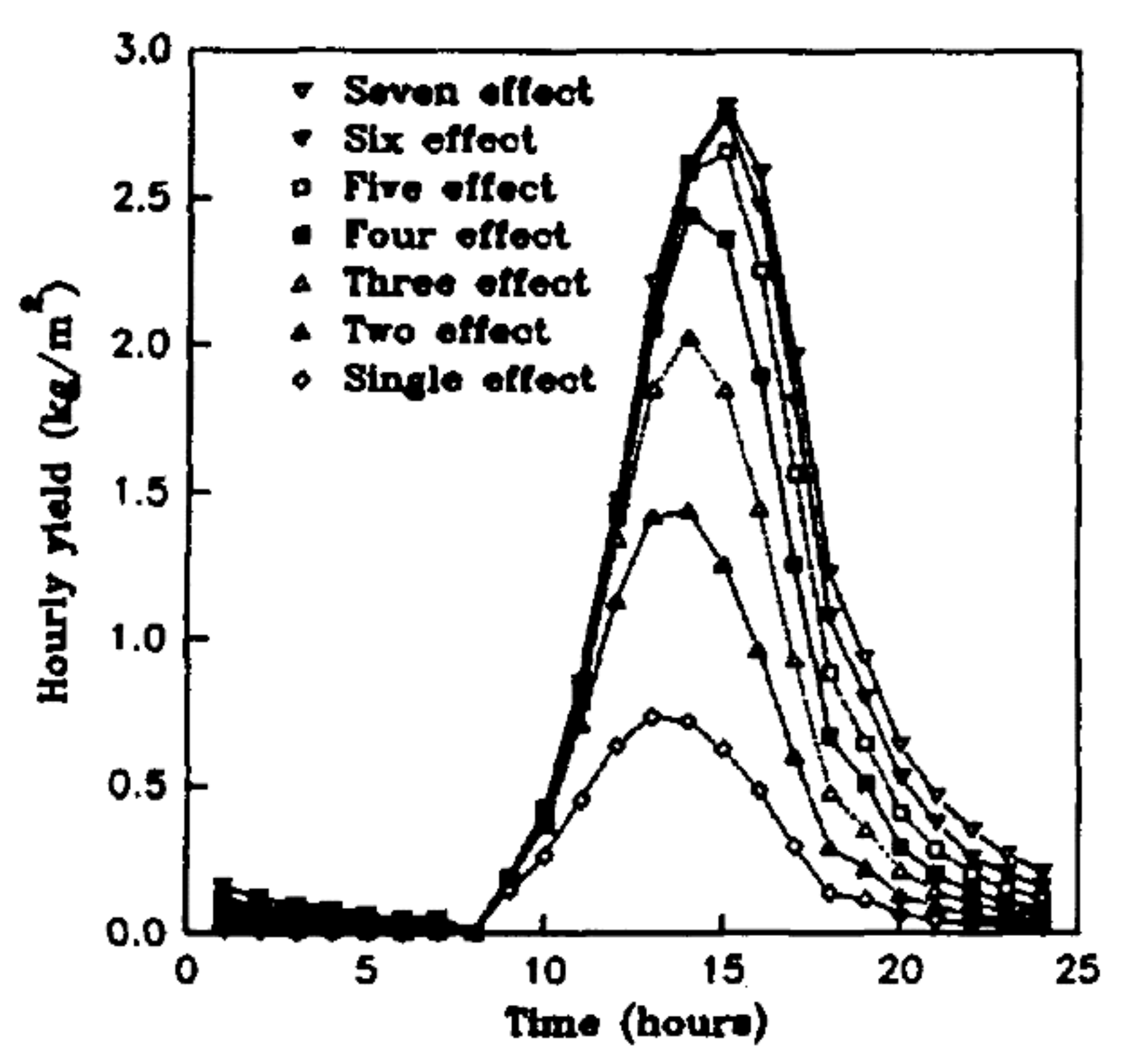


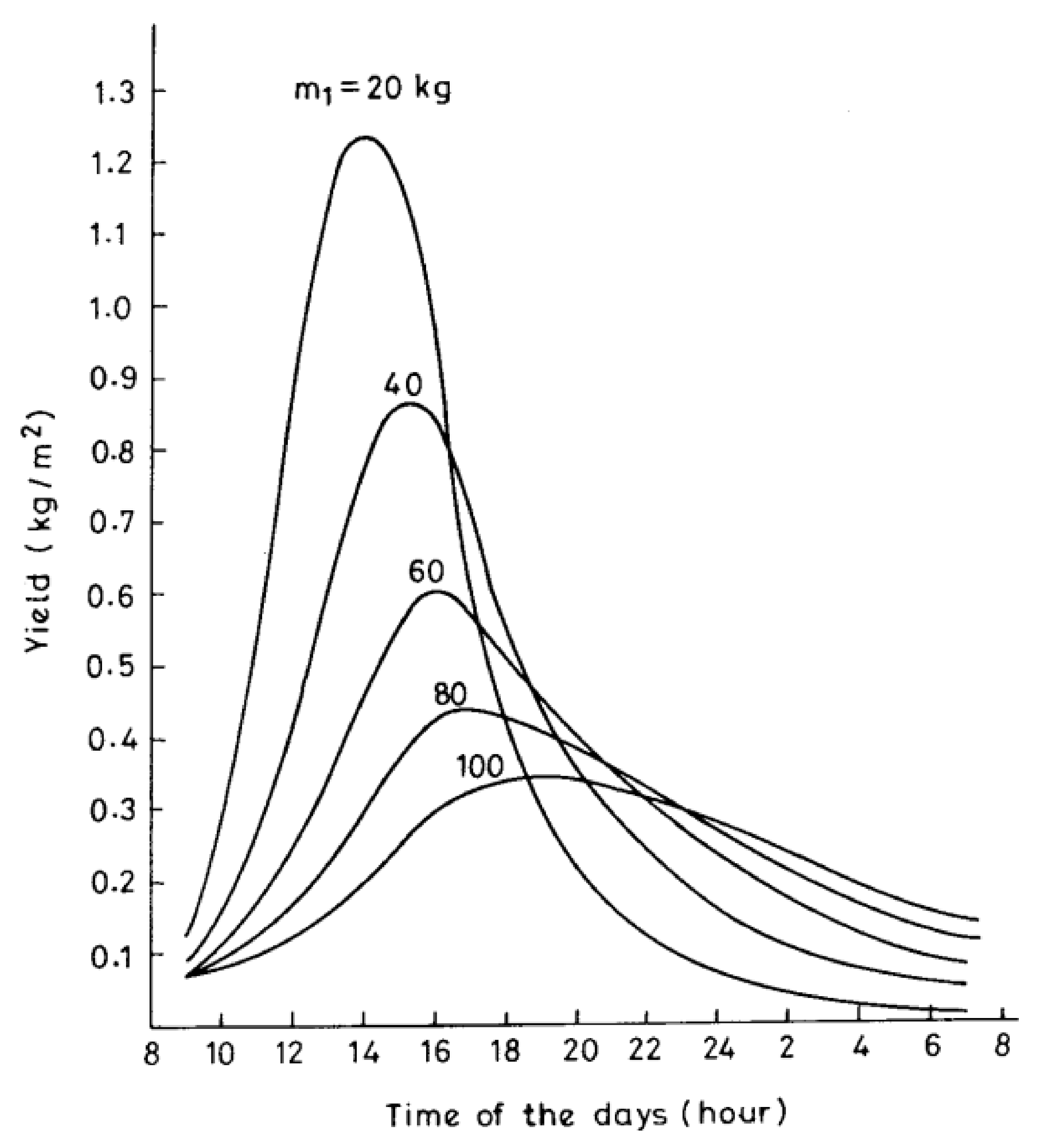
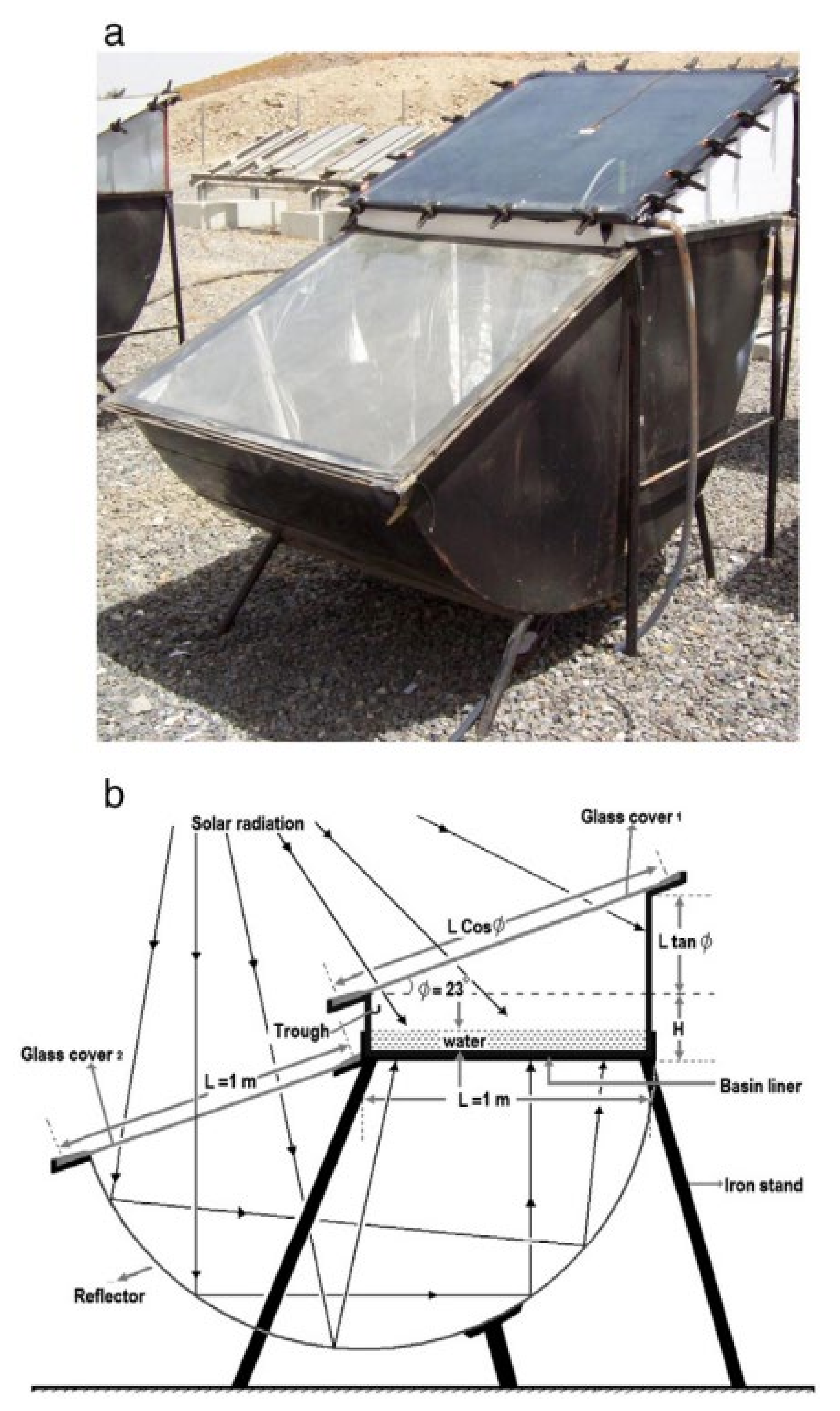
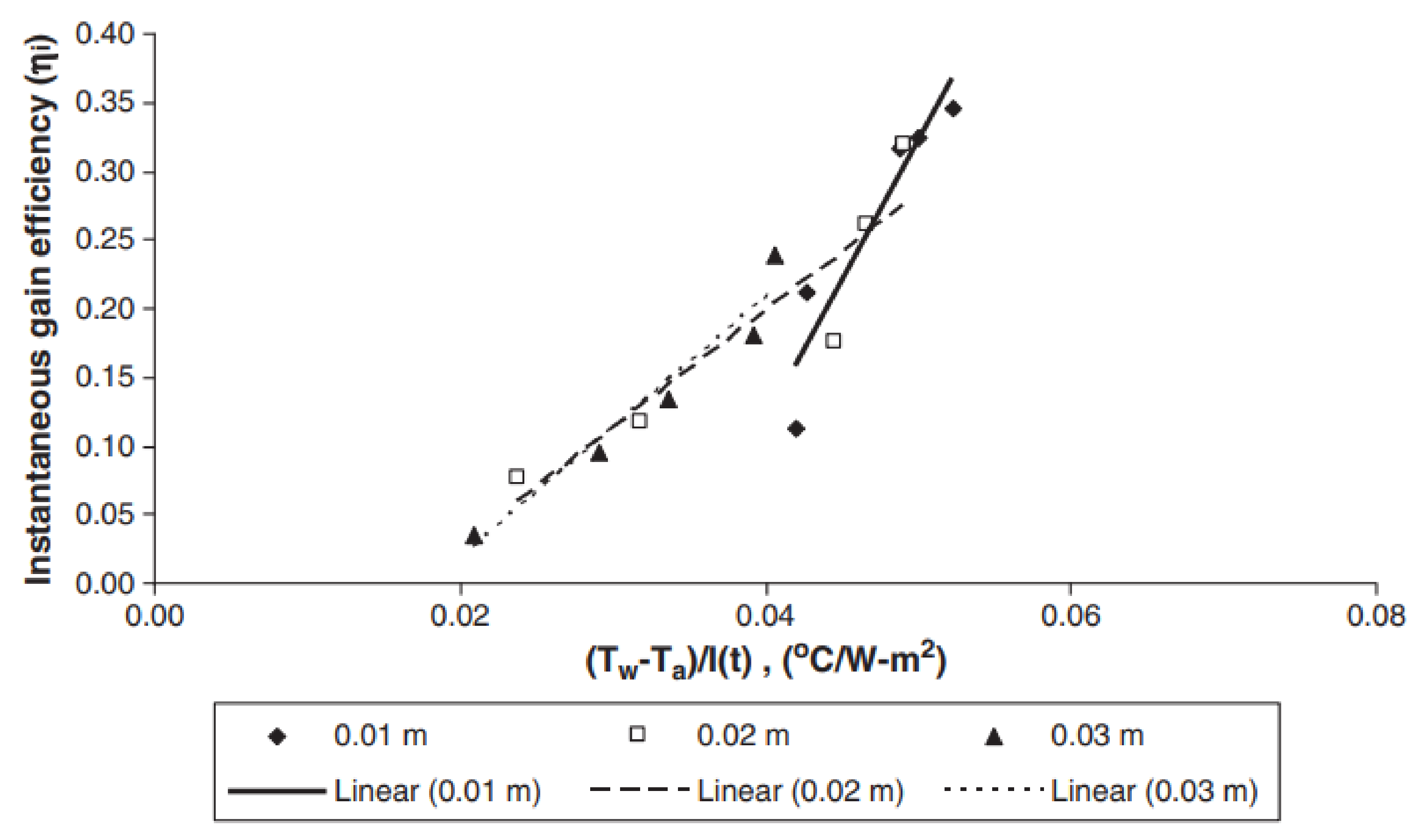
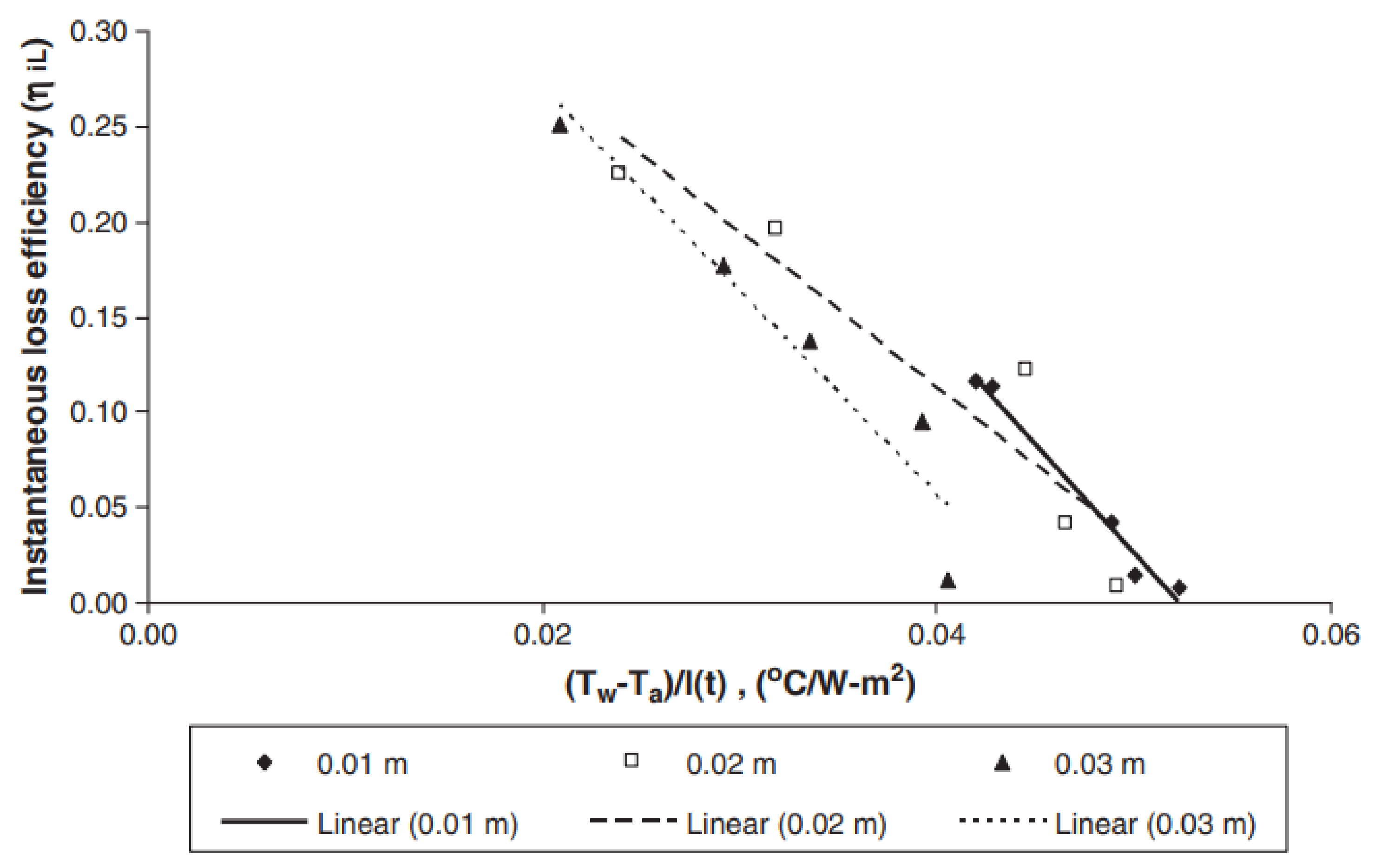
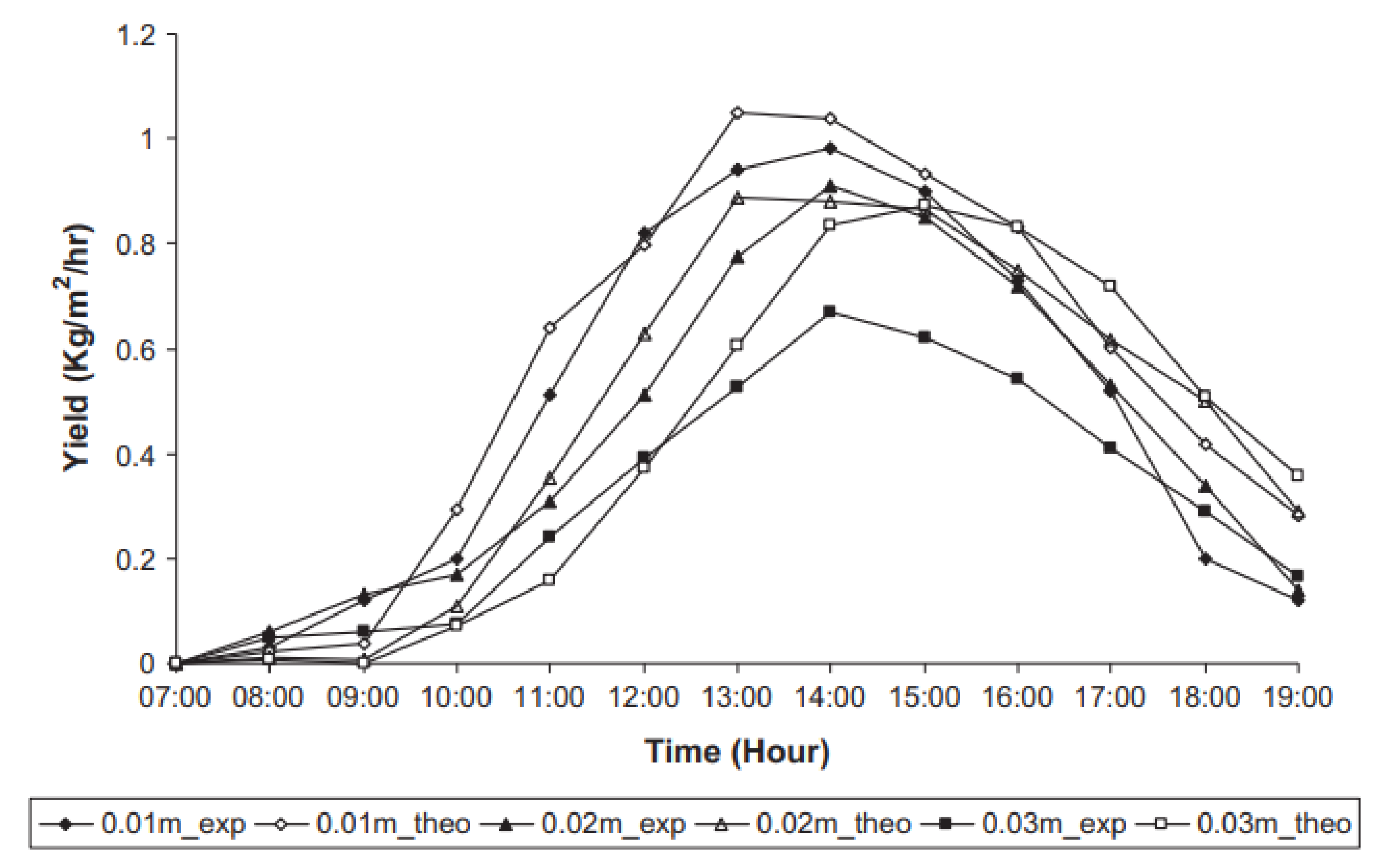
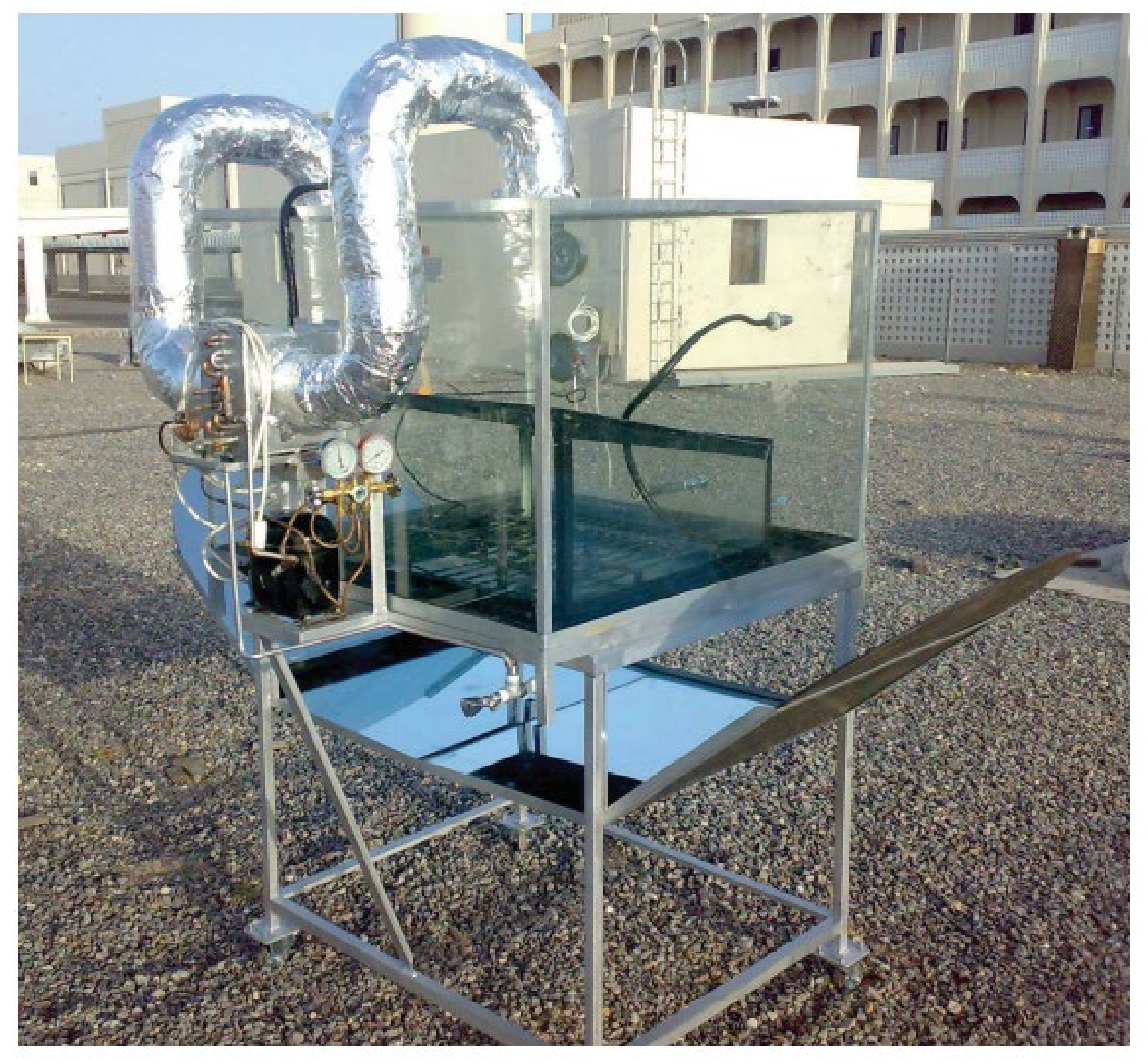

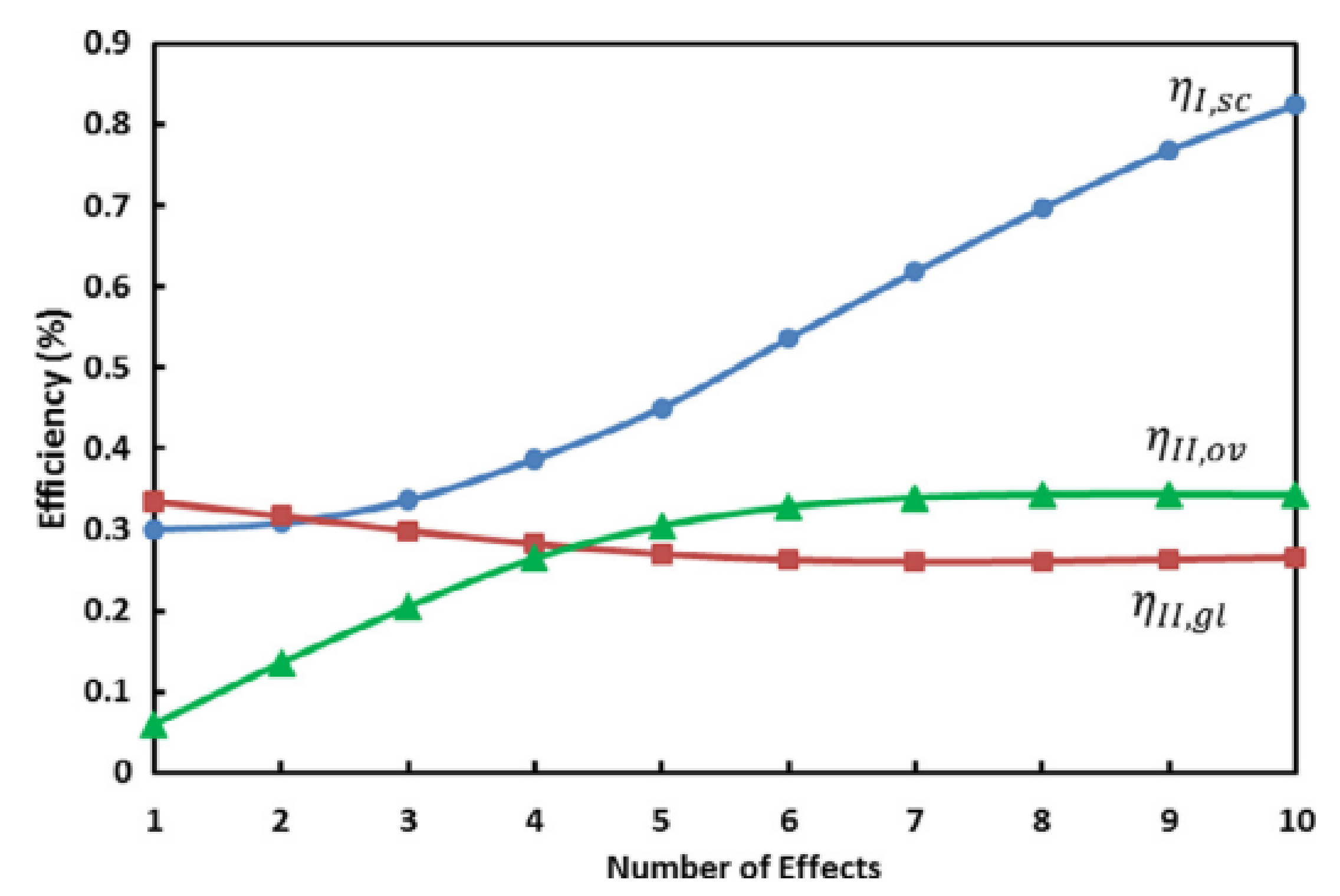
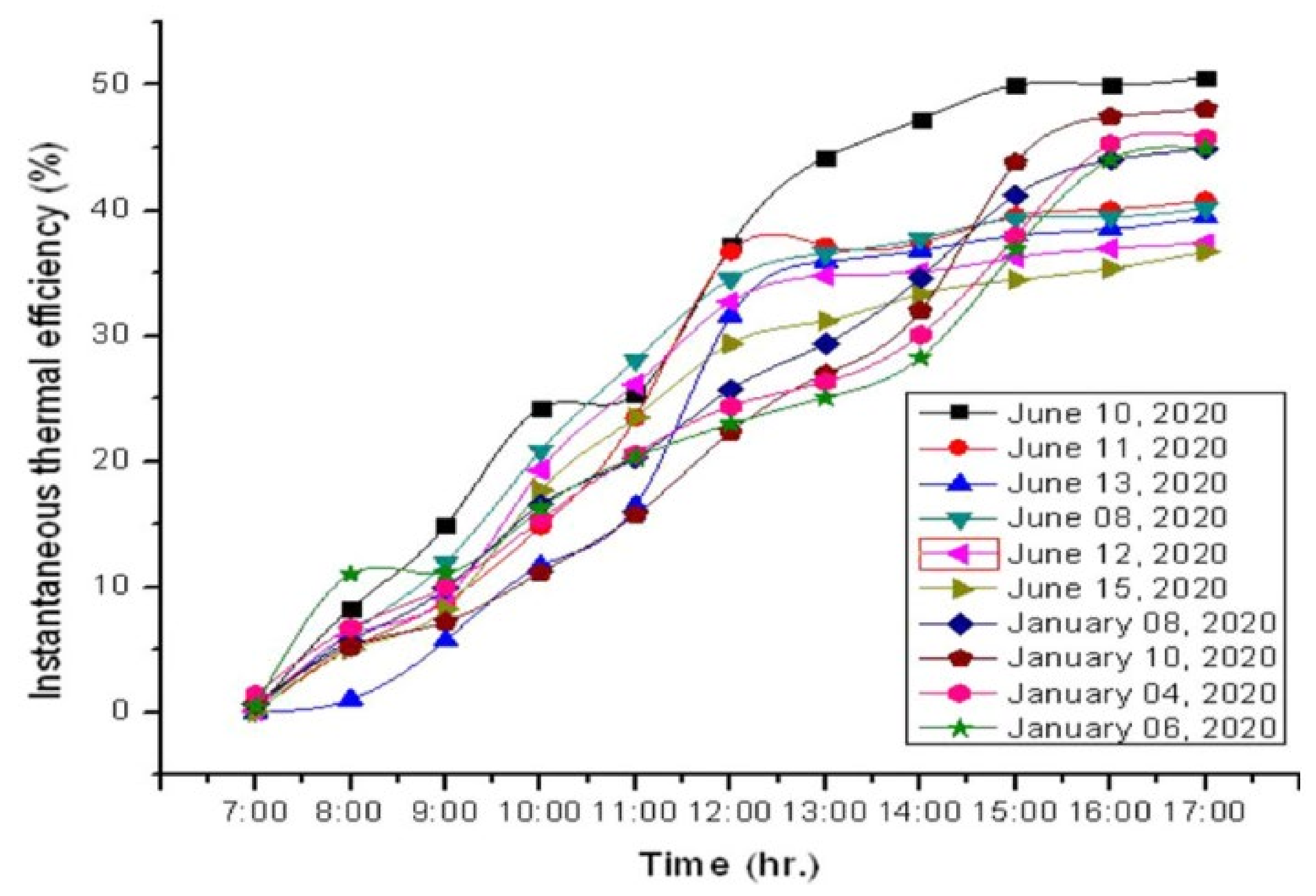
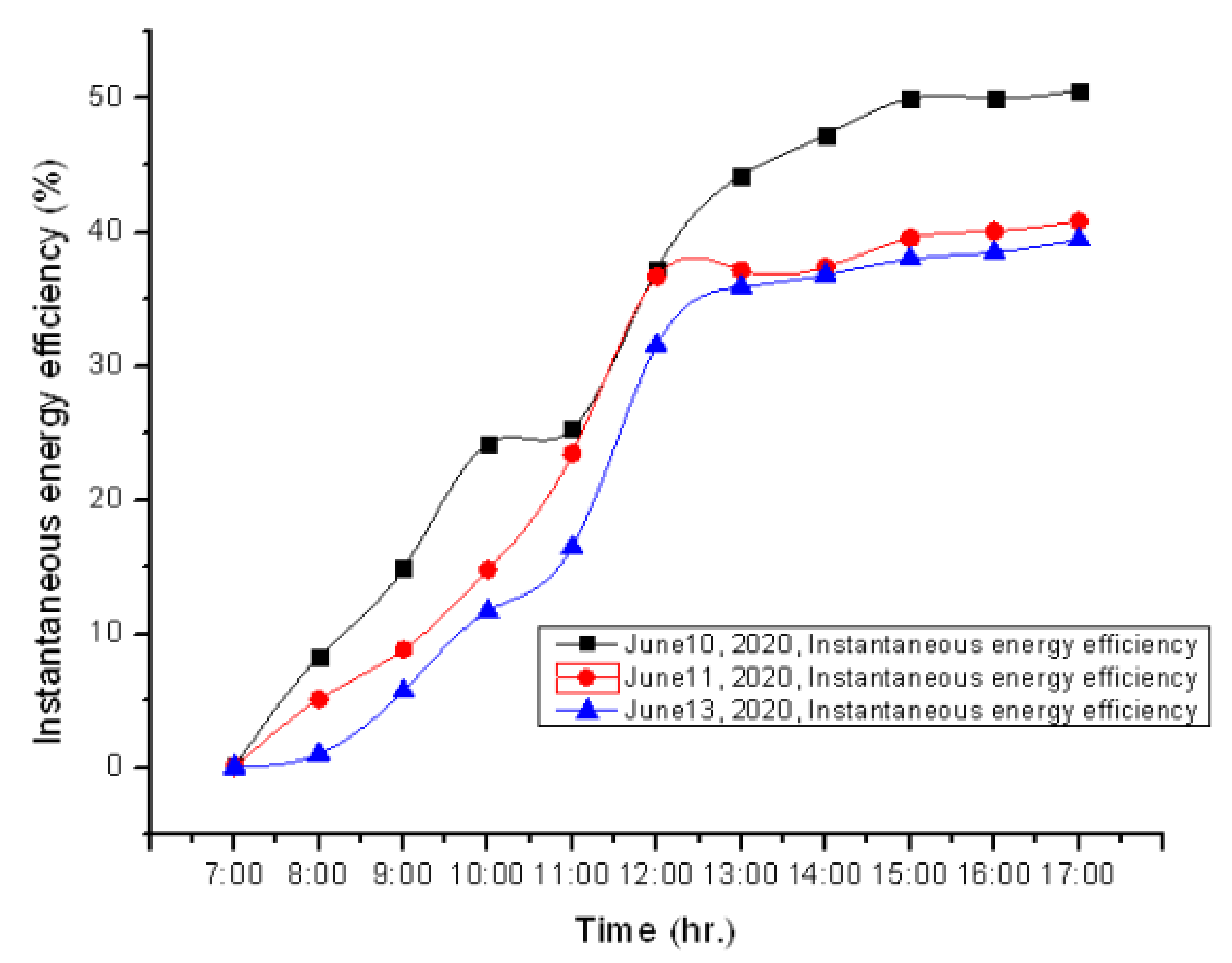

| Author | Location | Latitude | Inverted Solar Still Type | Testing Period (Hours)/Radiation (W/m2) | Method | Studied Parameters | Merits | Limitations |
|---|---|---|---|---|---|---|---|---|
| Badran and Hamdan (1995) [4] | Amman, Jordan | latitude 31°57′ N, longitude 35°55′ E | Inverted water trickle solar still | April | Experimental | Water type | The main components of this concept are the elimination of condensation on the glazing, which increases the amount of solar radiation reaching the absorber plate, as well as the elevation of the temperature difference between the evaporator and the condenser, which ultimately increases the productivity of basin-type stills. Combining the condensate with some of the intermediate products may improve productivity if the product’s salinity is impaired. If the feed was saltwater in this instance, the productivity might be improved to 5.8 L/m2/day of brackish water. | The size of the developed inverted water trickle solar still is the main issue and, therefore, might feasibly be expanded. |
| Suneja et al. (1997) [5] | Delhi, India | latitude 77°13′ N, longitude 0.1956″ E | Inverted absorber double-basin solar still | Min 100–Max 998 | Numerical | Water depth, absorptivity of the absorber plate, and initial water temperature | It has been found that, for a given water mass in the top basin, the daily yield of an inverted absorber double-basin solar still grows as the water depth in the bottom basin increases. | The yield of an inverted absorber double-basin solar still rises by around 10% for a given quantity of absorptivity and water depth, while the yield of an inverted absorber single-basin solar still rises by about 12% when the starting water temperature rises from 22 °C to 35 °C. The yield of an inverted absorber double-basin solar still declines by around 27% as the water depth in the bottom basin increases from 1 cm to 5 cm. The yield of a typical double-basin solar still increases by around 10% and about 43% as the absorber’s absorptivity goes from 0.45 to 0.65. Thus, it can be stated that the standard double-basin inverted absorber solar panel’s output is still less than that of the inverted absorber solar panel. |
| Suneja and Tiwari (1998) [6] | Delhi, India | latitude 77°13′ N, longitude 0.1956″ E | Multi-basin inverted absorber distiller | Min 100–Max 998 | Numerical | The effect of the reuse of latent heat of the vaporization from the lower basins | This design is characterized by recycling the latent heat of the vaporization from the matching lower basins which improve the daily yield. | It has been estimated that adding more than seven basins will only marginally boost production. |
| Tiwari and Suneja (1998) [7] | Delhi, India | latitude 77°13′ N, longitude 0.1956″ E | Inverted absorber solar still | Min 100–Max 998 | Numerical | Water depth | A normal solar still only produces about half as much as an inverted absorber solar still. | As a result of less heat leaving from the bottom of the still and more heat being absorbed by the inverted absorber plate, it has been determined that inverted absorber solar stills cause a considerable increase in water temperature. Additionally, with increasing water depth, the daily production falls. |
| Suneja and Tiwari (1999) [8] | Delhi, India | latitude 77°13′ N, longitude 0.1956″ E | Inverted absorber double-basin solar still | Min 100–Max 998 | Numerical | Water depth | The system produces the highest possible overall output when the water depth in the bottom basin is at its shallowest point. In addition, in contrast to the traditional solar distillation system, the suggested system would only need a minimal amount of money to operate and maintain since the absorber is inverted. | With increasing water depth in the bottom basin, an inverted absorber double-basin solar still produces more power each day. |
| Tiwari and Suneja (1999) [9] | Delhi, India | latitude 77°13′ N, longitude 0.1956″ E | Inverted absorber solar still | Min 100–Max 998 | Numerical | Water depth | The yield is observed to rise by roughly 11% when there is a flow of water at the rate of 0.5 kg/s for an ideal 10 cm depth of water in the basin. | The yield drops as the water depth in the basin rises, directly affecting the low operating temperature. |
| Badran (2001) [10] | Amman, Jordan | latitude 31°57′ N, longitude 35° 55′ E | Inverted trickle solar still | May | Experimental | The heat exchanger inside the condenser insulates the sides of the still and feeds the flow rate | Expanded the flow rate of the saline water supply and increased productivity by adding a heat exchanger within the condenser. In turn, the productivity was raised from roughly 2.5 L/d to 2.8 L/d by insulating the still’s sides and increasing the flow rate of the saltwater supply. For a 50% flow rate increase, productivity was boosted by roughly 42%. | According to the research, the inverted trickling solar still has a straightforward construction and a productivity range of 1.7 to 3.83, depending on the salinity of the feed water. When desalinating excessively saline water, production is severely impacted. Consequently, it has been recommended to combine the condensate with some of the intermediate products. |
| Abdul-Wahab et al. (2010) [11] | Muscat, Oman | latitude 23°37′ N, longitude 58°35′ E | Inverted absorber solar still with a curved reflector | September | Experimental | Reflector, insulation under the basin | Under the basin of an IASS, an improved single-slope solar still design is a curved reflector. This configuration improves the basin’s direct and indirect heating from both sides (that is, the top and bottom surfaces). | The IASS’s inability to hold thermal energy for an extended period of time is discovered after 16:00. The decrease in the amount of solar radiation that is reflected causes the thermal storage to be lost to the environment through the enclosed air underneath the basin. |
| Dev et al. (2011) [12] | Muscat, Oman | latitude 23°37′ N, longitude 58°35′ E | Inverted absorber solar still | July Min 125–Max 995 | Analytical and experimental | Water depth and thermal storage effect | While the values of instantaneous loss efficiency (iL) drop due to the water’s thermal storage effect, the instantaneous gain efficiency increases as the water depth rises. It was found that the lower water depth is 0.01 m with better values of ηi, ηiL, and mew over other water depths; hence, 0.01 m water depth can be endorsed for solar stills. | The inverted absorber solar still exhibits nonlinear behavior. |
| Dev et al. (2011) [13] | Muscat, Oman | latitude 23°37′ N, longitude 58°35′ E | Inverted absorber solar still | July Min 125–Max 995 | Experimental | Water depth, reflector under the basin | When compared to a single-slope solar still at the same relative water depths, the inverted absorber solar still has the ability to significantly raise the water temperature. The basin’s performance in comparison to the SS for seawater is not greatly enhanced by the addition of a reflector. At water depths (dw) of 0.01, 0.02, and 0.03 m, the IASS yields are 6.302, 5.576, and 4.299 kg/m2/day, respectively. The optimal water depth for the IASS is 0.03 m, and adding a reflector beneath the basin does not significantly worsen its performance compared to the SS for seawater. | The inverted absorber solar still has a constraint after 16:00 h. Due to the low input of solar light from the bottom, the temperature of the water drops more quickly. This could be a result of the bottom heat loss, which is the reverse heat flow from water to enclosed air in the reflector assembly, and then from there to ambient air. Convection heat loss from the metallic basin to the air enclosed by the reflector assembly is another way to describe this. As the ambient temperature drops further, this bottom heat loss rises. Due to heat storage being lost via the metallic bottom to the ambient air, this phenomenon impacts the nocturnal yield output. |
| Abdul-Wahab and Al-Hatmi (2012) [14] | Muscat, Sultanate of Oman | latitude 23°37′ N, longitude 58°35′ E | Refrigerated inverted solar still | July | Experimental | Refrigeration cycle, water depth | In comparison to the standard inverted solar still, the chilled inverted solar still may produce more potable water each day. Contrary to the typical inverted sun still, which displayed the opposite behavior and where it was implied that reducing the water depth might improve the daily production, increasing the water depth could enhance the daily production of the inverted refrigerated solar still. | The high initial cost and large land requirements for installation as well as the output are quite dependent on the existing solar radiation. |
| Abdul-WahabandAl-Hatmi (2013) [15] | Al Khoud, Oman | latitude 23°37′ N, the longitude of 58°35′ E | Inverted absorber solar stills paired with a refrigeration | --- | Experimental | Water depth | The inverted absorber solar stills paired with refrigeration (RIASS) were capable of producing more potable water than IASS. At 4, 6, and 8 cm of water depth, the RIASS daily yields were 6.4, 10.08, and 9.5 L/day, respectively. The IASS’s respective daily yields were 3.41, 3.24, and 2.92 L/day, which were less than the RIASS’s. | The high initial cost and large land requirements for installation as well as the output are quite dependent on the existing solar radiation. |
| Sain et al. (2013) [16] | Jaipur, Rajasthan | latitude 26°55′ N, longitude 75°52′ E | Inverted absorber and single-slope solar still | June | Experimental | Ambient temperature, inverted-type absorber plate, water depth, and reflector | Ambient temperature improves productivity by around 12% to 23%. The thermal efficiency of a single-slope solar PV rose by 7% when an inverted absorber plate was utilized. The output falls by 5% as the water depth rises from 0.01 to 0.03 m; the solar still productivity may rise by 3% with the use of reflectors. Thus, the usage of reflectors increased the IASS’s overall effectiveness. | Despite the enhancement of overall efficiency, the inverted absorber and single-slope solar still have a propensity for salt deposition, scale, and corrosion. |
| Badran et al. (2004) [17] | Amman, Jordan | latitude 31°57′ N, longitude 35°55′ E | Inverted trickle solar still | November Min 580–Max 1000 | Experimental and numerical | Brackish water, feed water flow rate | The major part of the still was an absorber plate that was upside-down and had a black top. Condensation occurred inside a heat exchanger between a 47 and a 32-degree inclination to provide heat recovery. The maximum condensate collection rates at the aforementioned angles were 2.8 and 2 L/d, respectively. By employing brackish water, the inverted trickle solar still’s production is somewhat increased. When the water’s salinity was changed from saltwater (35,000 ppm) to brackish water, the productivity rose from 2.5 to 2.8 L/d (6000 ppm). Productivity rose significantly when the feed water flow rate was reduced to 0.7 g/s. | It is not useful to deal with a high saline water. This is due to the decrease in the amount of product water. |
| Badran and Jaradat (2016) [18] | Amman, Jordan | latitude 31°57′ N, longitude 35°55′ E | Inverted trickle solar still | September Min 450–Max 1090 | Experimental | Length of the heat exchanger and flow rate. | The intermediate header is about twice as productive as the condensate header. The daily efficiency of the still also increased. Statistically, productivity climbed by 15% while efficiency rose by 8.6%. This occurred as a result of the increase in the heat exchanger’s length, which increased the heat transfer area. The still was more productive at a flow rate of 1.0 g/s than at a flow rate of 1.8 g/s. | Dealing with highly saline water is useless. This is because there is less product water. |
| Shanazari and Kalbasi (2018) [19] | Iran | latitude 51°24′ N, longitude 15.6348″ E | Inverted absorber multi-effect solar still | - | Numerical | Number of basins | When additional basins are added, there is an initial rise in the overall exergy loss, but then there is a subsequent drop. A gentle decline in total exergy loss may be seen as the result of this change. Simply expanding the number of basins from seven to ten results in a meager 0.7% reduction in the overall exergy loss. It was discovered that elevating the number of basins from one to ten results in a rise in the overall irreversibility from 15.67 to 17.3 MJ, which is a rise of 10.4%. | The productivity of an inverted absorber multi-effect solar still depends on a number of factors. Production was negatively correlated with wind speed, condenser emissivity, condenser thickness, and salinity of the water, whereas ambient temperature, sun intensity, and evaporation area were directly correlated with productivity. Due to the irreversibility of the various system components, there is a necessity to investigate the influence of the number of basins and the number of effects on the exergy loss using the thermodynamics first law for different locations. |
| Karimi et al. (2020) [20] | Zahedan, Iran | latitude 29°29′46″ N, longitude 60°51′46″ E | Basin solar still with a curved inverted reflector under the basin | - | Experimental | Wind velocity, basin area, number of photovoltaic cells, and water depth | There were a few solar cells inserted in the condenser’s glass cover. The technology simultaneously produces electrical power and potable water. An increase in the water depth reduces freshwater productivity while having essentially no effect on the amount of energy produced, according to the results of a parametric analysis. | Increasing the use of solar cells reduces the amount of freshwater produced but increases energy production. Moreover, while adding more solar cells may boost the system’s electrical efficiency, it may also reduce its heat efficiency. |
| Singh and Sharma (2021) [21] | Mathura, India | latitude 27°29′ N, longitude 77°40′ E | Modified multi-wick basin-type inverted absorber solar still | June and January Min 10–Max 880 | Experimental | Wicks of black cotton and jute, water depth | The rate of yield production, the amount of heat taken in, and the overall thermal efficiency all rose noticeably. In the modified multi-wick basin-type inverted absorber solar still (MMWBIASS), the yields with black cotton and jute wicks were 2.994 kg/m2 day and 2.847 kg/m2 day, respectively, at a water level of 0.01 m. As a result, even though BCW was utilized instead of JW to make the display, the output increased by 4.91%. | Detailed research is required to better evaluate absorbing material and the distance between each shelf to enhance the productivity of fresh water. |
| Singh and Sharma (2021) [22] | Mathura, India | latitude 27°29′ N, longitude 77°40′ E | Modified multi-wick basin-type inverted absorber solar still | June Min 280–Max 850 | Experimental | Water depth | The instantaneous efficiency of the solar still was studied using cotton wicks of a dark hue. The overall output at 1, 2, and 3 cm of water depth on a specific day in June 2020 was 6907, 5.681, and 4.650 kg/m2 day, respectively. The yield was higher at the shallower water depth. It has been noted that as the water level rises, so does the yield of the modified multi-wick basin-type inverted absorber solar still (MMWBIASS). | To increase the production of fresh water, a thorough analysis of superior absorption materials and the space between shelves is needed. |
| Javadi et al. (2021) [23] | Iran | latitude 30°20′ N, longitude 48°18′E | Combined cycle power plant | --- | Experimental | Combined cycle | Three distinct configurations in which the Abadan Combined cycle power plant would combine with a solar power tower system were tested. The system in its first configuration had the highest energy and exergy efficiency, at 42.56% and 39.42% respectively, as well as the lowest starting cost among the three configurations. Additionally, the emissions from the combined power plant were reduced by 8041 tons per year thanks to this method. | There is a necessity to carry out process optimization to elevate the exergy losses of the developed configurations and enhance energy efficiency. |
| Singh and Sharma (2022) [24] | Mathura, India | latitude 27°29′ N, longitude 77°40′ E | Multi-wick basin-type inverted absorber solar still | June and January Min 10–Max 880 | Experimental | Black cotton and jute wicks, water depth | The maximum instantaneous energy efficiency was achieved with jute cloth and black cotton wicks, respectively, at 15.27% and 11.88%. With jute and black cotton wicks at 0.01 m of water depth, the total multi-wick basin-type inverted absorber solar still (MMWBIASS) efficiency was measured at 27.68% and 34.04%, respectively. | A careful examination of excellent absorption materials and available space between shelves is required to maximize the production of fresh water. |
| Javadi et al. (2022) [25] | The U.S. | latitude 38°53′ N, longitude 77°1′ E | Multi-generation system for hydrogen | --- | Analytical | Multi-generation system | The multi-generation system for hydrogen comprises a concentrated solar power tower cycle, a steam-methane reforming cycle, a hydrogen-gas turbine, and a reverse osmosis desalination cycle. The multi-generational system produces 12.9 megawatts of electrical power, 96.18 kg per second of potable water, and 5.2 kg per second of hydrogen. | Most of the exergy destruction takes place across the entire system. |
Publisher’s Note: MDPI stays neutral with regard to jurisdictional claims in published maps and institutional affiliations. |
© 2022 by the authors. Licensee MDPI, Basel, Switzerland. This article is an open access article distributed under the terms and conditions of the Creative Commons Attribution (CC BY) license (https://creativecommons.org/licenses/by/4.0/).
Share and Cite
Hussein, A.K.; Rashid, F.L.; Abed, A.M.; Al-Khaleel, M.; Togun, H.; Ali, B.; Akkurt, N.; Malekshah, E.H.; Biswal, U.; Al-Obaidi, M.A.; et al. Inverted Solar Stills: A Comprehensive Review of Designs, Mathematical Models, Performance, and Modern Combinations. Sustainability 2022, 14, 13766. https://doi.org/10.3390/su142113766
Hussein AK, Rashid FL, Abed AM, Al-Khaleel M, Togun H, Ali B, Akkurt N, Malekshah EH, Biswal U, Al-Obaidi MA, et al. Inverted Solar Stills: A Comprehensive Review of Designs, Mathematical Models, Performance, and Modern Combinations. Sustainability. 2022; 14(21):13766. https://doi.org/10.3390/su142113766
Chicago/Turabian StyleHussein, Ahmed Kadhim, Farhan Lafta Rashid, Azher M. Abed, Mohammad Al-Khaleel, Hussein Togun, Bagh Ali, Nevzat Akkurt, Emad Hasani Malekshah, Uddhaba Biswal, Mudhar A. Al-Obaidi, and et al. 2022. "Inverted Solar Stills: A Comprehensive Review of Designs, Mathematical Models, Performance, and Modern Combinations" Sustainability 14, no. 21: 13766. https://doi.org/10.3390/su142113766
APA StyleHussein, A. K., Rashid, F. L., Abed, A. M., Al-Khaleel, M., Togun, H., Ali, B., Akkurt, N., Malekshah, E. H., Biswal, U., Al-Obaidi, M. A., Younis, O., & Abderrahmane, A. (2022). Inverted Solar Stills: A Comprehensive Review of Designs, Mathematical Models, Performance, and Modern Combinations. Sustainability, 14(21), 13766. https://doi.org/10.3390/su142113766









